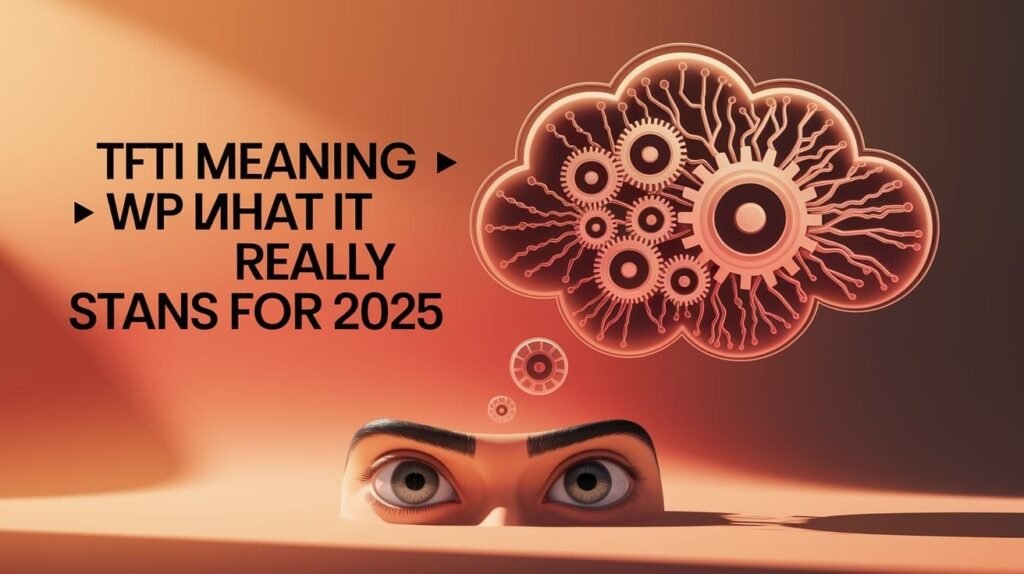In today’s fast-paced digital world, acronyms and abbreviations have taken over everyday conversations—especially in texts, group chats, and social media posts. One such term you’ve likely seen is TFTI. TFTI Meaning What It Really Stands, and how should you use it? Short for “Thanks For The Invite,” this popular expression is part of modern text slang used across platforms like Instagram, Snapchat, WhatsApp, and Twitter. While it may seem simple at first glance, TFTI can carry both sincere gratitude and subtle sarcasm, depending on how and when it’s used.
As part of a growing trend in internet acronyms and social media abbreviations, understanding terms like TFTI helps you stay current with casual texting language. Whether you’re responding to an event, reacting to a post, or playfully calling out a friend for excluding you, knowing how to use TFTI correctly makes your communication clearer and more relatable. In this guide, we’ll explore what TFTI stands for, its tone, its origins, and how to use it in various real-life and online situations—so you never miss a beat in the digital conversation.
What Does TFTI Stand For?
TFTI stands for Thanks For The Invite.
It’s often used in a sarcastic way when someone feels left out. For example, if your friends went out to dinner and didn’t invite you, you might comment “TFTI” under their group selfie on Instagram.
Breakdown:
- T = Thanks
- F = For
- T = The
- I = Invite
TFTI Meaning in Text
When someone texts you “TFTI,” they may not be genuinely thankful. Instead, it’s usually said with a bit of shade. The tone can depend on the context, but it usually means:
- “Wow, I wasn’t invited.”
- “Thanks for not inviting me.”
- “Nice of you to include me—NOT!”
So, while the words say “thanks,” the true meaning might be closer to “I feel left out.”
Where Did TFTI Come From?
TFTI is a product of internet slang, evolving during the rise of texting and social media in the early 2000s. Like LOL, BRB, and SMH, it became a quick way to express feelings without typing a full sentence.
It was commonly seen in:
- Facebook comments
- Instagram captions
- Twitter replies
- Snapchat messages
- Group chats
How Do People Use TFTI Today?
Let’s explore different scenarios where TFTI is used, and the tone it carries:
1. Playful Sarcasm
Example:
Your coworker brings donuts but didn’t tell you.
You text: “TFTI 🍩”
Here, it’s lighthearted, maybe even funny.
2. Real Disappointment
Example:
Your close friends hang out without you.
You comment on their story: “Wow… TFTI.”
This one stings. It’s often used to express hurt or sadness.
3. Mock Gratitude
Example:
Someone shares a surprise party that you weren’t told about.
You reply: “Such a fun night, huh? TFTI.”
It’s a mix of sarcasm and resentment.
TFTI vs TYFTI: What’s the Difference?
- TFTI = Thanks For The Invite (usually sarcastic)
- TYFTI = Thank You For The Invite (more sincere)
So if someone says TYFTI, they probably actually mean it.
What Are Some Related Internet Slangs?
To understand TFTI better, it helps to know other text slang terms used in similar ways:
| Slang | Meaning | Tone |
| SMH | Shaking My Head | Disappointed, annoyed |
| FOMO | Fear Of Missing Out | Jealousy, exclusion |
| IDC | I Don’t Care | Dismissive |
| IMO | In My Opinion | Casual input |
| IDK | I Don’t Know | Unsure |
| WYD | What You Doing? | Curious or casual check-in |
All of these are shortcuts to emotion. Just like TFTI, they pack a lot of feeling into a few letters.
Tone and Emotion Behind TFTI
Though it seems simple, TFTI carries emotion. Here’s how people usually feel when using it:
- Left out
- Sad
- Angry
- Playful
- Joking
- Annoyed
It’s all about context. Tone matters in real life, but online, tone is read through emojis, punctuation, and who’s talking.
When Not to Use TFTI
TFTI can seem rude or passive-aggressive if the other person doesn’t know you’re joking.
Avoid using TFTI:
- In professional settings
- With someone you don’t know well
- In formal emails
- If you’re truly upset (talk instead)
How to Respond to TFTI
Someone says TFTI—now what?
Here are a few ways you can reply:
1. If it’s sarcastic but friendly:
“Oops! Next time, I promise. 😅”
2. If you forgot to invite them:
“I’m so sorry! Totally slipped my mind.”
3. If they’re joking:
“LOL TFTI back 😜”
4. If you want to clear things up:
“Didn’t mean to leave you out—come next time?”
TFTI in Memes and Pop Culture
TFTI memes are all over the internet. They usually show someone:
- Standing alone with a sad face
- Looking out the window
- Crashing a party uninvited
The caption? TFTI.
TFTI is also used in:
- Tweet screenshots
- Instagram reels
- TikTok reaction videos
- Snapchat stickers
Examples of TFTI in Sentences
Let’s see TFTI used in real-world situations.
Example 1:
Friend: “Beach day with the crew 🏖️”
You: “TFTI! Looks fun though 😒”
Example 2:
Coworker: “Lunch was great!”
You: “TFTI. I was two desks away 😂”
Example 3:
Sibling posts party pics without telling you:
You comment: “TFTI 🙃 guess I wasn’t cool enough lol”
Is TFTI Only for Younger People?
Not at all.
While Gen Z and Millennials use it more, anyone can say TFTI. It’s simple and easy to understand.
Still, it fits best in casual conversation, so your parents might not drop a “TFTI” in the family group chat—unless they’re hip to the slang.
Alternatives to Saying TFTI
Want to say it without using the slang? Try these:
- “Wow, thanks for letting me know…”
- “Would’ve been nice to be invited.”
- “Cool party. Too bad I didn’t get the memo.”
- “Looks fun! Maybe next time?”
- “Wish I had known about this!”
Same message, just more words.
Why Do People Use TFTI?
It’s all about speed and sarcasm. People use TFTI to:
- Save time typing
- Make a joke
- Express hurt without confrontation
- Sound trendy or witty
- Be passive-aggressive without being mean
In many cases, it’s used more for effect than emotion.
Conclusion: TFTI Is More Than Just Four Letters
While TFTI literally means “Thanks For The Invite,” it often means so much more. From jokes to jabs, it’s a quick way to say, “I noticed you didn’t include me.” Whether you’re texting a friend, replying to a story, or joking in a group chat, the tone behind it can say more than words ever could.
So next time you see TFTI, remember—it might not mean “thanks” at all.
5 Unique FAQs About TFTI
1. Is TFTI rude or sarcastic?
Yes, most of the time. While it can be a joke, it’s often used to express feeling left out, usually with a sarcastic tone.
2. Can TFTI be used in a funny way?
Definitely! Friends often use it in a playful way to tease each other, especially in group chats or casual banter.
3. Is there a positive way to say TFTI?
Yes—use TYFTI (Thank You For The Invite) if you’re genuinely thankful. It sounds more polite and sincere.
4. Should I use TFTI in a professional setting?
No. TFTI is casual slang and can come off as unprofessional or passive-aggressive. Stick to polite wording at work.
5. Is TFTI used worldwide or just in the U.S.?
TFTI is common in English-speaking countries, especially the U.S., UK, and Canada. It’s widely understood online but not always used in everyday speech globally.

Muhammad Haroon is a passionate writer and a visionary creator. With a deep commitment to sharing wisdom and positivity, he has dedicated his work to inspiring others through his thoughtful words and meaningful content. As the founder of Blessings Zings, Muhammad combines his expertise in writing with his love for spreading joy and gratitude.

